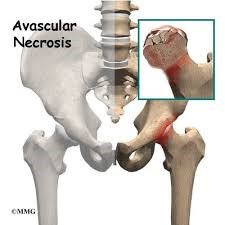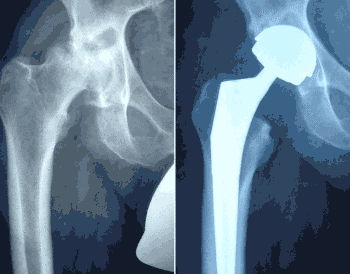Aseptic necrosis of the femoral head
A full range of orthopedic services, from diagnosis to full recovery
Aseptic necrosis of the femoral head – avascular necrosis, is a consequence of impaired blood flow and necrosis of the elements of the bone marrow of the femoral head. Blood supply to the femoral head is carried out through the vessels located in the femoral neck. Idiopathic osteonecrosis of the femoral head is a severe degenerative-dystrophic lesion of the hip joint, observed in the most able-bodied age.

& nbsp; Nhbxbys
Many factors can lead to the development of aseptic necrosis. Almost any cause that contributes to the disruption of blood flow in the artery of the femoral head can be a trigger for the development of necrosis. The following reasons are distinguished:

DIAGNOSTICS
Treatment with aseptic necrosis usually occurs in the later stages, when pain is present and the functionality of the limb decreases. Diagnosis of aseptic necrosis of the femoral head includes the following most common methods:

TREATMENT
The treatment strategy for aseptic necrosis is determined by the stage of the disease and the severity of clinical symptoms. Currently, the effectiveness of drugs aimed at restoring blood circulation has not been proven. In the early stages, the use of analgesic and anti-inflammatory drugs is effective. Our clinic also uses decompression techniques followed by the administration of platelet-rich plasma or bone marrow concentrate. At stage 3-4, surgical treatment in the form of hip replacement is indicated.

ENTRUST THE CARE OF YOUR HEALTH TO REAL PROFESSIONALS!

& nbsp; Nhbxbys
Many factors can lead to the development of aseptic necrosis. Almost any cause that contributes to the disruption of blood flow in the artery of the femoral head can be a trigger for the development of necrosis. The following reasons are distinguished:
-
traumatic injuries. In this case, necrosis develops after a few months, although the first clinical symptoms usually appear in patients much later (often 1.5-2 years after the injury);
taking some medications. Most often, necrosis develops against the background of long-term administration of high doses of glucocorticoid hormones;
excessive alcohol intake. Alcohol contributes to the damage of blood vessels, which can cause the development of ischemia of the femoral head and the development of its necrosis;
high pressure exposure (divers, miners). If the decompression mode is not correct, small air bubbles form in the blood, which can clog and damage blood vessels, including leading to a violation of blood flow through the artery of the femoral head.
- Stage I-the patient does not yet know about the upcoming disease. Microscopic changes in the bone structure are not detected by all diagnostic methods. Sub-cartilaginous osteonecrosis develops, in which the spongy substance of the femoral head is affected with unchanged cartilage. The zone of structural changes is no more than 10%;
- Stage II-there may be a slight discomfort in the affected area. There is a compression fracture, in which the surface of the femoral head has cracks of the "cracked shell" type. In the zone of loading of the trabecula, thin bone plates have cracks of a spiral shape or foci of micro-collapse. The zone of structural changes is no more than 10-30%
- Stage III-when moving, there are pains that do not disappear at rest. This is the stage of fragmentation, which is characterized by uneven contours of the femoral head, a slight degree of collapse, the appearance of several foci of compaction or cystic degeneration. The inter-articular space narrows or expands. The zone of structural changes is no more than 30-50%
- Stage IV-acute pain even in the supine position, the joint is devoid of functionality. There is a dislocation or subluxation. The head is completely destroyed. The structure of the trabeculae is dissolved or compacted, the crack bands are irregular in shape. The inner or outer edges of the acetabulum are displaced. The interarticular space is narrowed or disappeared. The area of structural changes is 50-80%

DIAGNOSTICS
Treatment with aseptic necrosis usually occurs in the later stages, when pain is present and the functionality of the limb decreases. Diagnosis of aseptic necrosis of the femoral head includes the following most common methods:
-
radiography of the hip joint in two projections is an old conventional method;
magnetic resonance imaging-this method allows you to see the appearance of aseptic necrosis already in the initial stages (edema of the bone marrow). Narrowing of the joint space and irregularity of the articular surface is rendered later, when there are significant degenerative changes.

TREATMENT
The treatment strategy for aseptic necrosis is determined by the stage of the disease and the severity of clinical symptoms. Currently, the effectiveness of drugs aimed at restoring blood circulation has not been proven. In the early stages, the use of analgesic and anti-inflammatory drugs is effective. Our clinic also uses decompression techniques followed by the administration of platelet-rich plasma or bone marrow concentrate. At stage 3-4, surgical treatment in the form of hip replacement is indicated.

ENTRUST THE CARE OF YOUR HEALTH TO REAL PROFESSIONALS!
Product rating is: 0 from 5
Please rate the product:
Advantages of treatment in Orthopedics by Ruslan Sergienko
-
10 years on medical services in Ukraine
-
> 25 years of experience with leading specialists
-
Anna Vovchenko and Ruslan Sergienko are recognized opinion leaders among the orthopedic traumatologists
-
> 150,000 consultations were held
-
> 7,500 surgeries were performed
-
All types of pain management
-
The operating unit is equipped according to international standards
-
Availability of all medicines and supplies
-
Single rooms, equipped with the characteristics of orthopedic patients
-
Three meals a day
-
Postoperative rehabilitation by certified specialists
-
Pricing Transparency
